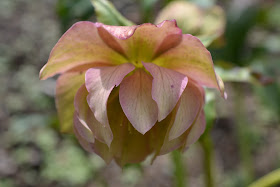Long-time readers may remember that I have a stream and waterfall in my garden.
 |
| View of the stream, through the gate, back in 2012 |
But I haven't written about it or posted photos of it in close to two years. About a year and a half ago, in the fall of 2015, we started having problems with it. It has an auto-fill valve, that we discovered was stuck in the "on" position. In the summer, with constant evaporation, that wasn't a problem. When the fall rains returned, the stream overflowed its banks across the patio and into the lawn.
We turned off the valve, and removed a lot of water. Then I decided to give it a good cleaning. Since it's situated underneath Douglas firs, a lot of fir debris drops into it, so I used a shop-vac to vacuum up the needles. When I turned it back on, it seemed to be losing water, and I thought it had a leak somewhere, so I pulled a lot of rocks away from the edges to try to find whether it was leaking along the edges. Over the years, it has been a powerful attractant for raccoons, and they have disturbed the edges every time they play in the water, so I wondered if maybe they had done some damage.
So we turned it off. Eventually, winter came, I started to ignore it and all the piles of rocks strewn on the patio near it and on the other bank. And that winter I had my gall bladder taken out and got an ulcer, and then came last year, the year of my discontent (migraines, anxiety, digestive and other health issues).
Now, the stream is getting sorted out. We've turned it back on, and it seems to be running fine, with no leaks. We still haven't turned the auto-fill valve back on. I've started putting the rocks back.
 |
| A closer, more current view of the messy stream |
 |
| The opposite bank near the fence, with weeds, piles of rocks and neglected plants |
 |
| Stream liner showing |
 |
| More stream liner showing |
One thing I noticed for the year and a half that the stream was turned off -- the raccoons began to ignore our garden. They weren't as attracted to the entire area, and came less and less often to wreak destruction, running through my garden beds, playing, trampling plants, using certain areas of the garden as a toilet. I still find evidence that they've been searching for grubs in the lawn, but they don't dig in the soft soil of the beds, and they don't stick around to play.
So, because they come mostly at night, I wondered if maybe there was a way to set the stream up on a timer to turn it off at night and on again in the morning? Nigel found a wireless, weather-proof outlet on Amazon that we can use to operate the stream from our cellphones at the press of a button. Right now we're doing it every night and every morning, but there also is apparently a way to set it up to turn on and off automatically at sunrise and sunset.
 |
| The solution to our raccoon problem? |
I have plans for new plants, both in and around the stream. I'll keep you posted on the progress.






















































